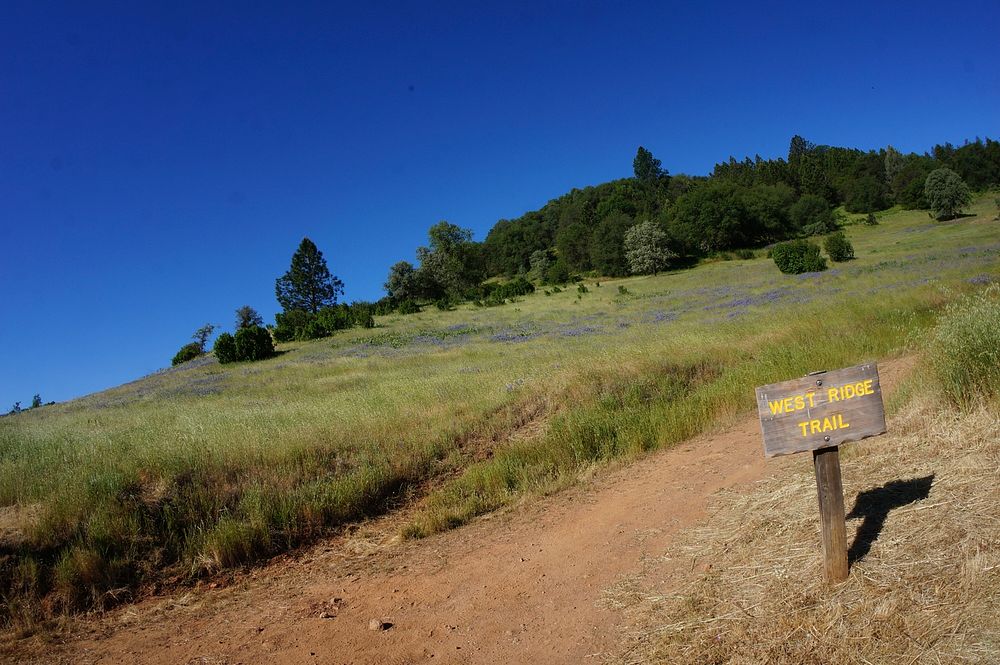
This month when you see the cottony clouds floating across the rolling green slopes of Cronan Ranch Regional Trails Park, take a closer look – they may actually be our woolly grazers, returning this spring to the popular BLM-managed public lands around the South Fork American River.
Just a few miles upstream of Folsom Reservoir, the Cronan Ranch trails are used by more than 30,000 hikers, equestrians and mountain bikers each year.
The sheep’s main objective is to target the invasive noxious weed, yellow star-thistle (Centaurea solstitialis), which appropriately enough arrived here in the 1850’s from Europe in contaminated alfalfa, spreading throughout the West with the transport of fodder seed and railroad building materials’ (footnote 1 and 2). The weed grows quickly and outcompetes most of the native wildflowers and grasses. It is also toxic to horses, making it a serious risk along the miles of equestrian trails which connect Cronan to Magnolia Ranch Trailhead, Dave Moore Nature Area and Greenwood Creek River Access. The spiny blooms for which the weed is named can be problematic for other recreationists passing through as well, from paragliders and flyfishers to dogs and their walkers.
Over the past century, the suppression of natural, low-intensity wildfire has not only thrown off regular cycles of succession for native annuals, but has disproportionately favored yellow star-thistle to spread without its natural environmental controls. Because of its longer taproot, it can also withstand higher intensity wildfires than native annuals – wildfires which are unnaturally higher in intensity due to the abnormal fuel buildup as a result of too much fire suppression. On a local level, only well-timed combinations of prescribed fire, targeted grazing during bloom and/or herbicides have been found to successfully control this weed at a landscape scale (footnote 3). More targeted grazing means less herbicide is needed to combat the invasive species along these high-traffic areas.
Upon their initial arrival four years ago, the sheep had not yet developed their palates for yellow star-thistle and impact was mixed. But after a couple of years of training by the shepherd, returning sheep had learned to seek out yellow star-thistle specifically – and they are teaching their offspring to prefer the weed as well.
Last year, native populations of purple needlegrass (Nassella pulchra) were found regenerating in meadows at Cronan Ranch from where they were thought to have disappeared. Purple needlegrass is the California State Grass, and it is a standard material for Native American Indian basketweaving. BLM botanists Beth Brenneman and Graciela Hinshaw are working to multiply the seed and aid in its recovery.
This project is another great example of how restoring native biodiversity tends to produce countless downstream benefits for society – it reduces the fire hazard for neighbors, creates jobs and silvopastoral services, improves safety and aesthetics for recreationists on both the river and the trails, and secures water quality for everyone downstream.
Though visitors will likely be able to easily view the sheep on various pastures alongside the many trails, they are warned to stay at a safe distance from the temporary electric fencing and sheep dogs, and be sure to keep any pets from harassing the sheep while they are hard at work.
The herd will be moseying through rotating pastures of Cronan until the end of August, when they will hop on the next truck for greener pastures, literally. After that, some sheep may go to market, but most will return next year, many with new offspring, to pick up right where they left off – nipping these weeds in the bud while unknowingly revitalizing the range for everyone else.
Original public domain image from Flickr